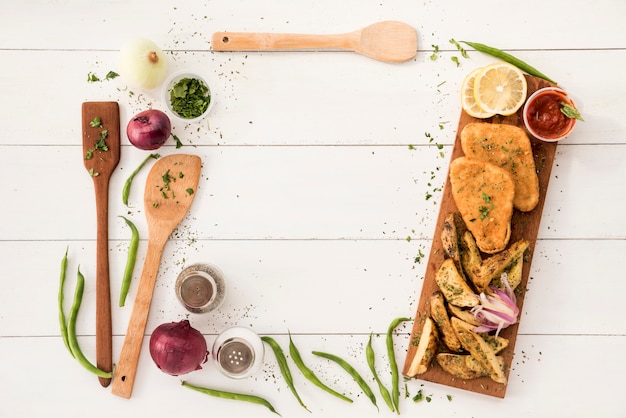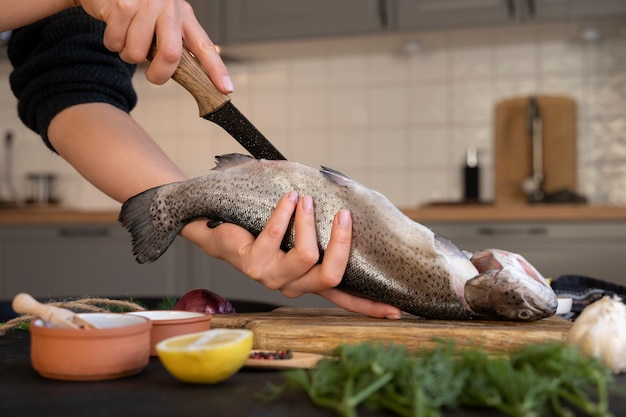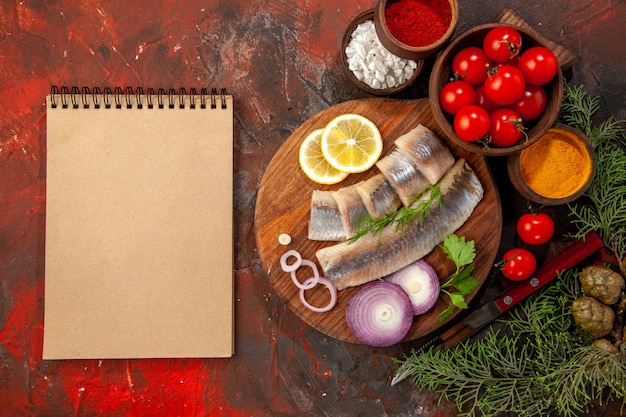Let's talk fish. Not just any fish, mind you, but how to cook it perfectly. You know, that golden-brown crust, the flaky texture, that melt-in-your-mouth goodness. I've been cooking for years, and let me tell you, fish can be a tricky customer. Overcook it, and you're left with a dry, rubbery mess. Undercook it, and you're risking food poisoning. Not a good look, right?
So, this guide is for all you fish-loving folks out there who want to level up their cooking game. We're going to dive deep into the world of fish cooking temperatures, and I'll share my tried-and-true methods for achieving that perfect, mouthwatering texture. Think of it as your ultimate fish-cooking handbook, from understanding the basics to mastering more complex techniques.
(Part 1) The Importance of Temperature

Why Temperature Matters in Fish Cooking
You might be thinking, "Isn't cooking fish just about throwing it in a pan and calling it a day?" Well, it's a little more nuanced than that, my friend. Fish is delicate, both in the ocean and in your kitchen. It cooks quickly, and if you're not careful, it can go from perfectly flaky to dry and tough in a flash. That's where understanding temperature comes in. It's the key to unlocking that incredible texture, the kind that melts in your mouth and leaves you craving more.
internal temperature: The Golden Rule
The golden rule for cooking fish is to reach an internal temperature of 145°F (63°C). That's the point where the fish is cooked through, but still juicy and tender. This applies to all types of fish, whether it's a delicate sole fillet or a chunky salmon steak. This is where a trusty meat thermometer comes in handy, folks. It's your best friend when it comes to ensuring your fish is perfectly cooked.
(Part 2) Understanding the Different Cooking Methods

Pan-frying: A Classic Technique
Ah, pan-frying. A classic technique for fish that, when done right, can be incredibly rewarding. For pan-frying, you want a hot pan, around medium-high heat. This helps create that beautiful golden crust on the fish. But remember, you need to be careful not to overcook it. Once the fish is golden brown on one side, flip it over and cook the other side. You'll know it's done when it flakes easily with a fork.
Baking: Perfect for Larger Cuts
Baking is another great option for fish, especially if you're cooking a whole fish or a large piece of fish. It's simple, allowing the fish to cook evenly and retain its moisture. Preheat your oven to 400°F (200°C) and place the fish on a baking sheet lined with parchment paper. Bake for 10-15 minutes, or until the internal temperature reaches 145°F (63°C). You can also use a marinade or glaze to add extra flavour to your baked fish.
Grilling: Bringing out the Smoky Flavors
Now, for the grill enthusiasts out there, grilling fish is a fantastic way to enjoy its smoky flavour. Just make sure your grill is nice and hot, around medium-high heat. Place the fish on the grill and cook for 3-5 minutes per side, or until it's cooked through. You can also use a grilling basket to prevent the fish from falling through the grates.
Steaming: A Healthy and Gentle Option
For a lighter, healthier option, steaming fish is a great choice. It allows the fish to cook gently in its own steam, retaining its natural moisture. Bring a pot of water to a boil and place a steamer basket over it. Place the fish in the steamer basket and cook for 5-10 minutes, or until it's cooked through.
(Part 3) Fish cooking time: The Thickness Factor

General Cooking Time: The Importance of Thickness
Here's the thing about cooking fish: it's all about the thickness. A thin fillet will cook much faster than a thick steak. As a general rule of thumb:
Thin fillets: 3-5 minutes per side
Thick steaks: 6-8 minutes per side
But remember, it's always best to use a meat thermometer to ensure your fish is cooked through.
Cooking Time Based on Fish Type: A Handy Table
Here's a table showing the approximate cooking times for different types of fish:
| Fish Type | Cooking Time (Minutes) |
|---|---|
| Salmon | 10-15 |
| Cod | 8-10 |
| Tuna | 6-8 |
| Halibut | 12-15 |
| Swordfish | 15-20 |
This is just a general guide, though. Cooking times can vary depending on the thickness of the fish, the heat of your oven or grill, and your personal preference for how you like your fish cooked.
(Part 4) Fish cooking tips: Elevating Your Game
Seasoning Your Fish: Beyond Salt and Pepper
A sprinkle of salt and pepper is a good start, but why stop there? Fish loves all kinds of spices and herbs. I like to use a mixture of herbs like dill, parsley, and thyme. You can also add some garlic powder, onion powder, or paprika for extra flavour. Experiment and find your favourite combinations!
Marinating Fish: A Burst of Flavor
Marinating your fish before cooking adds a whole new dimension of flavour. You can use a simple marinade of olive oil, lemon juice, and herbs, or get creative with something more complex. Just make sure to marinate the fish for at least 30 minutes, and up to a few hours, to allow the flavours to penetrate.
Glazing Fish: Adding Sweetness and Shine
For a touch of sweetness and shine, try glazing your fish. A glaze can be made with honey, soy sauce, and ginger, or you can use a store-bought glaze. Brush the glaze over the fish towards the end of the cooking time to let it caramelize.
Resting Fish: Essential for Tenderness
This one's crucial, folks! After you take your fish off the heat, let it rest for 5-10 minutes before serving. This allows the juices to redistribute, creating a more tender and flavourful fish. Patience is key here, I promise!
(Part 5) Signs of Overcooked Fish: Avoiding the Dryness
The Tell-Tale Signs: Recognizing Overcooked Fish
You know that feeling when you bite into a piece of fish and it's dry and rubbery? It's a real bummer, and it's usually a sign of overcooking. Here are some other signs to look out for:
The fish is flaky, but the flakes are dry and crumbly.
The fish is white and opaque, rather than translucent and slightly pink.
The fish sticks to the pan or grill.
What to Do If You Overcook Fish: Salvage the Situation
Don't fret if you accidentally overcook your fish. There are a few things you can do to salvage the situation:
Add moisture: You can try adding some lemon juice, broth, or wine to the pan to help rehydrate the fish.
Serve it with a sauce: A creamy sauce or a flavorful gravy can mask the dryness of the fish.
Shred it for a salad or sandwich: If the fish is too dry to eat on its own, you can shred it and add it to a salad or sandwich.
(Part 6) Understanding Different Fish Types: Cooking for Success
Fatty Fish: Rich Flavor and Moisture
Fatty fish like salmon, mackerel, and tuna have a higher fat content, which gives them a rich flavour and keeps them moist when cooked. These fish are best cooked using methods that highlight their natural oils, such as grilling, baking, or pan-frying.
Lean Fish: Retaining Moisture is Key
Lean fish like cod, haddock, and sole are lower in fat, which means they can dry out easily if overcooked. These fish are best cooked using methods that retain moisture, such as steaming, poaching, or baking.
Shellfish: Quick Cooking and Flavorful Delights
Shellfish like shrimp, crab, and lobster have their own set of cooking rules. They cook quickly, so it's important to keep an eye on them. You can grill, steam, saute, or bake shellfish.
(Part 7) The Art of Fileting Fish: A Skill to Master
Preparing Fish for Cooking: From Whole Fish to Fillets
Now, let's talk about how to handle your fish before you even get to the cooking part.
First, you want to make sure you've got a sharp knife. A good filleting knife is a must-have for any serious cook. This allows you to cut through the fish cleanly, without crushing or tearing the delicate flesh.
Next, you want to make sure the fish is properly cleaned and scaled. This involves removing any scales, gills, and entrails. You can usually buy fish that's already prepped, but if you're feeling adventurous, you can learn to do it yourself.
Now, you're ready to fillet your fish. This is where a little practice comes in handy. You want to make a clean cut along the spine of the fish, and then separate the fillets from the bones.
Common Mistakes to Avoid: Achieving Perfect Fillets
Cutting too deep: Be careful not to cut too deeply into the flesh, as this will result in a messy fillet.
Not removing the skin: You can leave the skin on for a more rustic look, but if you prefer a skinless fillet, make a cut along the skin and carefully peel it off.
Cutting through the bones: Use a sawing motion to cut through the bones, and be careful not to tear the flesh.
(Part 8) FAQs: Your Fish Cooking Questions Answered
1. How do I know if fish is cooked through?
You can tell if fish is cooked through by using a meat thermometer. Insert the thermometer into the thickest part of the fish, and make sure it reaches an internal temperature of 145°F (63°C). You can also check to see if the fish flakes easily with a fork.
2. What should I do if my fish is undercooked?
If your fish is undercooked, it's best to cook it further. You can place it back on the stovetop or in the oven, or you can finish it under a broiler. Make sure to check the internal temperature with a meat thermometer to ensure it's cooked through.
3. Can I freeze fish?
Yes, you can freeze fish. Wrap the fish tightly in plastic wrap or aluminum foil, and place it in a freezer-safe bag. Frozen fish can last for up to 3 months.
4. What are some good ways to serve fish?
There are endless possibilities for serving fish! You can pair it with roasted vegetables, salads, rice, pasta, or potatoes. You can also use it in sandwiches, tacos, or stir-fries.
5. What are some tips for avoiding fishy taste?
Here are a few tips for avoiding fishy taste:
Use fresh fish. Fresh fish will have a much milder flavour.
Soak the fish in milk or buttermilk. This helps to absorb the fishy taste.
Cook the fish quickly. Overcooked fish is more likely to have a fishy taste.
Use flavorful ingredients. Strong spices and herbs can help to mask the fishy taste.
And there you have it, folks. A comprehensive guide to cooking fish like a pro. So next time you're craving a delicious and nutritious meal, don't hesitate to give fish a go. You'll be surprised at how easy it is to master this culinary art. Now, go forth and cook with confidence!
Everyone is watching

Corn on the Cob: The Ultimate Guide to Perfectly Cooked Ears
Healthy MealsAh, corn on the cob. Just the name evokes images of sunny days, barbecues, and that sweet, juicy flavour that ...

Perfect Pork Roast Oven Cooking Time: A Guide to Delicious Results
Healthy MealsThere's something truly satisfying about a perfectly roasted pork. The aroma alone is enough to make your mout...

Ham Cooking Time: How Long to Bake, Smoke, or Boil a Delicious Ham
Healthy MealsAh, ham. It's a classic, isn't it? A real crowd-pleaser, especially around holidays. And when done right, it'...

Scallops: The Ultimate Guide to Perfect Cooking
Healthy MealsAh, scallops. Those delicate, sweet, and utterly delicious morsels of the sea. They hold a special place in my...

Spaghetti Squash: The Ultimate Guide to Cooking and Serving
Healthy MealsRemember that time you saw spaghetti squash at the supermarket, looking all bumpy and strange, and thought, "W...
